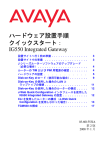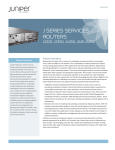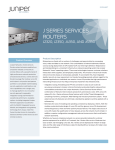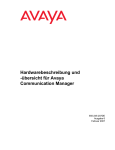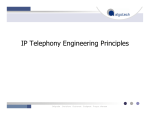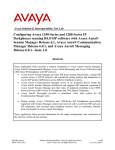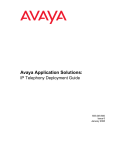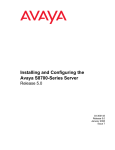Download to view the What`s new in AVAYA Call Manager 5 Fact Sheet
Transcript
What’s New in Avaya Communication Manager for Release 5.0 03-601528 Issue 2 January 2008 © 2008 Avaya Inc. All Rights Reserved. Notice While reasonable efforts were made to ensure that the information in this document was complete and accurate at the time of printing, Avaya Inc. can assume no liability for any errors. Changes and corrections to the information in this document may be incorporated in future releases. For full legal page information, please see the complete document, Avaya Support Notices for Software Documentation, document number 03-600758. To locate this document on our Web site, simply go to http:// www.avaya.com/support and search for the document number in the search box. Documentation disclaimer Avaya Inc. is not responsible for any modifications, additions, or deletions to the original published version of this documentation unless such modifications, additions, or deletions were performed by Avaya. Customer and/or End User agree to indemnify and hold harmless Avaya, Avaya's agents, servants and employees against all claims, lawsuits, demands and judgments arising out of, or in connection with, subsequent modifications, additions or deletions to this documentation to the extent made by the Customer or End User. Link disclaimer Avaya Inc. is not responsible for the contents or reliability of any linked Web sites referenced elsewhere within this documentation, and Avaya does not necessarily endorse the products, services, or information described or offered within them. We cannot guarantee that these links will work all of the time and we have no control over the availability of the linked pages. Warranty Avaya Inc. provides a limited warranty on this product. Refer to your sales agreement to establish the terms of the limited warranty. In addition, Avaya’s standard warranty language, as well as information regarding support for this product, while under warranty, is available through the following Web site: http://www.avaya.com/support. Copyright Except where expressly stated otherwise, the Product is protected by copyright and other laws respecting proprietary rights. Unauthorized reproduction, transfer, and or use can be a criminal, as well as a civil, offense under the applicable law. Avaya support Avaya provides a telephone number for you to use to report problems or to ask questions about your product. The support telephone number is 1-800-242-2121 in the United States. For additional support telephone numbers, see the Avaya Web site: http://www.avaya.com/support. Contents Chapter 1: New features and enhancements . . . . . . . . . . . . . . . Administrable IPSI Socket Sanity Timeout. . . . . . . . Avaya IA 770 INTUITY AUDIX Messaging Application . Avaya Video Telephony Solution enhancements . . . . Co-residency of Avaya Communication Manager and SIP Enablement Services . . . . . . . . . . . . . . Dial Plan enhancements. . . . . . . . . . . . . . . . . . Enbloc Dialing for DCP Telephones . . . . . . . . . . . Extension to Cellular enhancements . . . . . . . . . . ISDN CCBS Supplementary Service on Busy . . . . . . Survivable Call Detail Recording (CDR) . . . . . . . . . SIP Visiting User . . . . . . . . . . . . . . . . . . . . . . Other SIP- related enhancements . . . . . . . . . . . . Use trusted third party certificates for TLS connections XoIP Tone Detection Bypass . . . . . . . . . . . . . . . . . . . . . . . . . . . . . . . . . . . . . . . . . . . . . . . . . . . . . . . . . . . . . . . . . . . . . . . . . . . . . . . . . . . . . . . . . . . . . . . . . . . . . . . . . . . . . . . . . . . . . . . . . . . . . . . . . . . . . . . . . . . . . . . . . . . . . . . . . . . . . . . . . 5 6 6 6 . . . . . . . . . . 7 8 8 8 8 9 9 10 10 11 Chapter 2: Hardware . . . . . . . . . . . . . . . . . . . . . . . . . . . . 13 Avaya one-X Deskphone Edition IP telephones . . . . . . . . . . . . . . . . . 9610 IP telephone . . . . . . . . . . . . . . . . . . . . . . . . . . . . . . . 9620 IP telephone . . . . . . . . . . . . . . . . . . . . . . . . . . . . . . . 9630 IP telephone . . . . . . . . . . . . . . . . . . . . . . . . . . . . . . . 9640 IP telephone . . . . . . . . . . . . . . . . . . . . . . . . . . . . . . . 9650 IP telephone . . . . . . . . . . . . . . . . . . . . . . . . . . . . . . . Avaya one-X Desktop Value Edition - 1600 Series IP Telephones . . . . . . . 1603 IP . . . . . . . . . . . . . . . . . . . . . . . . . . . . . . . . . . . . . 1608 IP . . . . . . . . . . . . . . . . . . . . . . . . . . . . . . . . . . . . . 1616 IP . . . . . . . . . . . . . . . . . . . . . . . . . . . . . . . . . . . . . Avaya one-X™ Deskphone Edition - SIP Software for 9600 Series Telephones Avaya Agent Deskphone 16CC . . . . . . . . . . . . . . . . . . . . . . . . . . DAL2 duplication memory card. . . . . . . . . . . . . . . . . . . . . . . . . . G450 Media Gateway . . . . . . . . . . . . . . . . . . . . . . . . . . . . . . . Avaya S8730 Server . . . . . . . . . . . . . . . . . . . . . . . . . . . . . . . . Avaya IG550 Integrated Gateway . . . . . . . . . . . . . . . . . . . . . . . . . Telephony Interface Modules . . . . . . . . . . . . . . . . . . . . . . . . . . TIM508 analog media module . . . . . . . . . . . . . . . . . . . . . . . . . TIM516 analog media module . . . . . . . . . . . . . . . . . . . . . . . . . TIM518 analog media module . . . . . . . . . . . . . . . . . . . . . . . . . Index . . . . . . . . . . . . . . . . . . . . . . . . . . . . . . . . . . 13 13 13 14 14 15 15 15 16 16 17 18 18 18 19 20 21 21 21 21 23 Issue 2 January 2008 3 Contents 4 What’s New in Avaya Communication Manager Chapter 1: New features and enhancements This chapter presents an overview of the features and enhancements of Release 5.X of Avaya Communication Manager running on Avaya DEFINITY® servers, and the Avaya S8XXX-series servers with associated Avaya Media Gateways. The most current release of Communication Manager contains the features of prior releases. Other documents for Avaya Communication Manager release 5.X can assist you with this What’s New document: Note: ● For an overview of the features of Communication Manager, see the Overview for Avaya Communication Manager. ● For a more complete description of the features of Communication Manager, see the Feature Description and Implementation for Avaya Communication Manager. ● For more information on how to administer all features, and for a description of new and changed screens for this release, see the Administrator Guide for Avaya Communication Manager. ● For a description of new and changed commands for this release, see the Maintenance Commands for Avaya Communication Manager 5.0 Media Gateways and Servers. ● For a description of new hardware and how Communication Manager 5.0 affects various endpoints, see the Hardware Guide for Avaya Communication Manager 5.0 Media Gateways and Servers. ● For more information on upgrades and migrations for this release, see Upgrading, Migrating and Converting Media Servers and Gateways. ● For changes to system capacities and other related information, see the Avaya Communication Manager System Capacities Table for each release. ● For information on Co-residency of Avaya Communication Manager and SIP Enablement Services, see Administering SIP Enablement Services on the Avaya S8300 Server, Issue 1. Note: Not all Communication Manager Release 5.0 features are supported by all telephones and firmware. For a more complete reference, see the Hardware Guide for your particular telephone and firmware. Issue 2 January 2008 5 New features and enhancements Administrable IPSI Socket Sanity Timeout The Administrable IPSI Socket Sanity Timeout enables a link-bounce type of interval between Communication Manager and an IPSI to provide some resiliency during short network outages. During normal operations, Communication Manager determines the health of a connection to an IPSI by monitoring a heartbeat sent by the IPSI every second. If a heartbeat is missed and Communication Manager does not receive any other data from the IPSI, an IPSI sanity failure occurs. The number of IPSI sanity failures are counted and compared to the value (three to 15 seconds) set by an administrator for the IPSI Socket Sanity Timeout. The administered value of the IPSI Socket Sanity Timeout is the amount of time Communication Manager waits for communication to the IPSI to be restored before a recovery action is initiated. If the value for the IPSI Socket Sanity Timeout is properly engineered, the IPSI is less prone to warm starts and more resilient to short network outages. Prior to Communication Manager Release 5.0, it was possible to change the IPSI Socket Sanity Timeout by contacting Avaya Services. For customers upgrading to Communication Manager Release 5.0 with a value set by Avaya Services other than the three second default, the value set by Avaya Services is carried over during the upgrade. For more information, see Using the Avaya Enterprise Survivable Servers (ESS) 03-300428. Avaya IA 770 INTUITY AUDIX Messaging Application The Avaya IA 770 INTUITY AUDIX Messaging Application Release 5.0 (IA 770 R5.0) is an incremental development in the IA 770 product line. IA 770 R5.0 continues to provide embedded voice messaging for the Avaya Branch Office solutions. IA 770 R5.0 has the following new features and changes: ● IA 770 R5.0 can now be used with the MultiVantage Express product offer. ● IA 770 R5.0 supports the G450 Media Gateway with the S8300 Server. ● IA 770 supports Internet messaging with a gateway for e-mail messages in and out of the system. Users can create messages and send to e-mail recipients. For more information, see the IA 770 document set at www.avaya.com/support. Avaya Video Telephony Solution enhancements The Avaya Video Telephony Solution for Communication Manager Release 5.0 now supports: ● Ad-hoc video conferencing ● The Polycom RMX video conferencing bridge platform ● The Polycom HDX video conferencing system 6 What’s New in Avaya Communication Manager ● SIP video telephony For more information, see: ● Avaya Video Telephony Solution Release 4.0 Networking Guide, 16-601423, Issue 3 ● Video Telephony Solution Release 4.0 Quick Setup, 16-300310, Issue 4 ● IP Softphone and Video Integrator Getting Started, 16-600748, Issue 3 Co-residency of Avaya Communication Manager and SIP Enablement Services The Co-Residency of Avaya Communication Manager and SIP Enablement Services (SES) is a solution that helps reduce the cost of adding full, native support for SIP to your communications network by merging the hardware platforms of Release 5.0 of the Communication Manager software. The merged platform for co-residency is the Avaya S8300C Server, with compact flash replacing RAMDISK. With the co-resident hardware platform, SES and Communication Manager can operate more efficiently (for example, without firewall issues or the need to encrypt links between the two), and to share some of the same server resources and capabilities. Some of the pages of the Maintenance Web interface are also shared and reused, including the Web pages for system backup and restore capabilities. The system logging, process status and role-based web access controls also are the same for both. You can install Avaya’s IA770 voice mail with Communication Manager on S8300 Servers. Both the SES software and Communication Manager are installed, patched and configured as usual with a separate license for each. Thus the transition to the new co-resident implementation is easier for existing administrators. A server reboot is required after enabling SES on the S8300C. Communication Manager running in a co-resident implementation is supported as a main server only, and not as an Enterprise Survivable Server (ESS) or Local Survivable Processors (LSP). SES running in a co-resident implementation supports 100 SIP users, or the capacity of the gateway being used with the S8300C, if smaller. When SES is deployed co-resident with Communication Manager, the server must be configured as an SES Home server or combined Home/Edge server. Co-resident SES cannot be configured as a standalone Edge server, and therefore cannot be designated to perform core routing in an Avaya Distributed Office solution. A standalone SES Edge 5.0 (using an Avaya S8500 Server) is still required for these larger SIP implementations. For more information, see Administering SIP Enablement Services on the Avaya S8300 Server, 03-602508, Issue 1, November 2007. Issue 2 January 2008 7 New features and enhancements Dial Plan enhancements With Communication Manager Release 5.0, you can administer the Per-Location Dial Plan feature to allow different branches to have different short extensions. This feature prevents any conflict of extensions across branches. With the Multi-Location Dial Plan, you can use short number extensions for different locations. For more information, see the Feature Description and Implementation for Avaya Communication Manager. Enbloc Dialing for DCP Telephones The Enbloc Dialing and Call Type Digit Analysis feature available with Communication Manager 4.0, or later now works on DCP phones. This feature also works with H.323 and SIP terminals (96xx H.323 phones, Avaya one-X Mobile Edition for S60 3rd Edition Dual-Mode SIP phones). For more information, see the Feature Description and Implementation for Avaya Communication Manager. Extension to Cellular enhancements The Extension to Cellular (EC500) feature for Communication Manager 5.0 supports enhancements to multi-location features, and the Self Administration Feature Access Code (SAFE). The Confirmed Answer option is now available for the Cellular Voice Mail Avoidance feature. For more information, see: ● Feature Description and Implementation for Avaya Communication Manager ● Avaya Extension to Cellular User Guide ● Administrator Guide for Avaya Communication Manager ISDN CCBS Supplementary Service on Busy In Europe, Middle East and Asia (EMEA), the public network service providers support the ISDN Call Completion Busy Subscriber (CCBS) capabilities, where the service provider allows automatic callback for a busy subscriber. Communication Manager Release 5.0 implements ISDN CCBS Supplementary Services and thus enables automatic callback to the public network. 8 What’s New in Avaya Communication Manager For more information, see: ● Feature Description and Implementation for Avaya Communication Manager ● Administrator Guide for Avaya Communication Manager Survivable Call Detail Recording (CDR) Communication Manager Release 5.0 supports the Survivable Call Detail Recording (CDR) feature to store CDR records to the hard disk of server. For Enterprise Survivable Servers (ESS) and Local Survivable Processors (LSPs), the Survivable CDR feature is used to store the CDR records generated from calls that occur when an LSP or ESS server is controlling one or more gateways or port networks. For a main server, the Survivable CDR feature provides the ability to store CDR records on the server’s hard disk. Note: This feature is available on main servers and ESS servers that are Communication Manager 5.0 and later releases only. It is available on LSP platforms running Communication Manager 4.0 and later. Note: The Survivable CDR feature uses the same CDR data file formats that are available with legacy CDR. For more information, see: ● Feature Description and Implementation for Avaya Communication Manager ● Using the Avaya Enterprise Survivable Servers SIP Visiting User The SIP Visiting User feature enables users with the 9620 or 9630 SIP telephone to log in to any SIP phone in the enterprise and receive their own individualized services, menus, contacts, buddy lists and so on. A SIP Visiting User can always make emergency calls. SIP Visiting Users can be roaming or non-roaming. ● Non- roaming visiting user - If a visiting user is non-roaming, the user is logged into a visiting phone that is served by the user’s usual SIP Enablement Services (SES) home server. For example, a non-roaming visiting user logs into a phone that is in the office adjacent to their primary phone. No special connections need to be made to serve up the contacts, permissions and buddy lists that the non-roaming visiting user expects. ● Roaming visiting user - If a visiting user is roaming, the visiting user is logged into a phone that uses a SES home server that is different from the visiting user's home SES. During registration the roaming SES server retrieves the user’s credentials from the SES data service as the means to enable roaming for that user. Issue 2 January 2008 9 New features and enhancements For more information, see: ● Installing and Administering SIP Enablement Services for Release 5.0 ● SIP Personal Information Manager (SPIM) Users Guide Other SIP- related enhancements The following are some of the other SIP-related enhancements for Communication Manager Release 5.0: ● You can now assign the Extend Call telephone feature button to SIP telephones. With this button, the user of a SIP telephone can extend the current telephone call to an off-PBX/ EC500 telephone. ● Alternate Trunking now works with SIP trunks. ● SIP Service Provider Network Call Redirection is now available as a Communication Manager feature. Several Call Center functionalities that are supported on ISDN trunks are now also supported on SIP trunks. For more information on the screens and fields for administering these features, see the Administrator Guide for Avaya Communication Manager. Use trusted third party certificates for TLS connections Communication Manager and other applications running on a Communication Manager server rely on trusted certificates for secure interoperation. Customers can load and use X.509 certificates other than the Avaya Root certificate to manage trusted relationships within their networks. Certificates are stored in the file system in an area known as the trusted certificate store. At startup Communication Manager reads the trusted certificate store and adds the certificates to its internal cache of trusted certificates. This allows Communication Manager to recognize and create TLS connections to devices that use 3rd-party certificates. This functionality applies to all models of Linux based Communication Manager servers operating in any mode (main, LSP, ESS, active, standby): ● The tlscertmanage command loads a 3rd-party certificate into the Communication Manager repository for use the next time Communication Manager restarts. You must restart Communication Manager before it can recognize and use the newly-installed 3rd-party certificate. ● Communication Manager loads all of the trusted certificates in its repository into its runtime memory every time it starts. The Communication Manager certificate repository contains the following four (4) certificates by default: - Avaya Product Root Certificate Authority (CA) 10 What’s New in Avaya Communication Manager - SIP Certificate Authority - Motorola SSECA Root Certificate Authority - Spectel Root Certificate Authority All of these certificates are concatenated into the all-ca.crt file that is located in the /etc/ opt/ecs/certs/CA directory. The all-ca.crt file can contain up to eight (8) certificates, meaning that the customer may load up to four (4) additional 3rd-party certificates. For more information, see: ● Maintenance Commands for Avaya Communication Manager Media Gateways and Servers ● Maintenance Alarms for Avaya Communication Manager Media Gateways and Servers XoIP Tone Detection Bypass The X over IP Tone Detection Bypass feature (where X = modem, fax, TTY-TDD, etc.) serves customers using older or nonstandard external equipment such as modems, fax, TTY devices which are not easily recognized by VoIP resources within Communication Manager. By identifying this external equipment through administration, VoIP firmware determines whether to immediately attempt to put a call in pass-through mode, or allow the system to handle it as it does today. For more information on the screens and fields for administering this feature, see the Administrator Guide for Avaya Communication Manager. Issue 2 January 2008 11 New features and enhancements 12 What’s New in Avaya Communication Manager Chapter 2: Hardware This chapter presents an overview of hardware additions to Release 5.x of Avaya Communication Manager running on Avaya DEFINITY® servers, and the Avaya S8XXX series Servers with the associated Avaya Media Gateways. Avaya Communication Manager Release 5.x includes the following general hardware additions, or new software releases for telephone sets. Avaya one-X Deskphone Edition IP telephones With its wideband audio capability in combination with noise reduction, the 96xx-series telephones provide high fidelity clear sound. These telephones, when natively administered in Communication Manager, support 3 SBM24 and 96 buttons in Unicode. 9610 IP telephone The Avaya 9610 IP telephone is specifically designed for use in common areas such as building lobbies or hallways. In most instances, the 9610 telephone will not belong to a single user, but rather will be shared by visitors or building employees. Through its integrated web browser and backlit display, the 9610 supports productivity-enhancing phone applications such as access to building directories, visitor information, news, and events. For more information, see: ● Hardware Description and Reference for Avaya Communication Manager ● Avaya one-X™ Deskphone Edition for 9610 IP Telephone Quick Reference 9620 IP telephone The Avaya 9620 IP telephone is specifically designed for the everyday telephone user — those who rely on multiple communications tools such as email and instant messaging, yet still require a high-quality and intuitive telephone for voice communications. The high fidelity audio of the 9620 IP telephone provides crystal clear sound, eliminating background noise. The backlit display and intuitive interface simplifies access to critical telephone features, such as one-touch dialing from the contact list and accessing recent call information from call logs. Through its integrated web browser and application interface, the 9620 supports productivity-enhancing phone applications such as corporate LDAP directories and the receipt of broadcast reminders and alerts. For more information, see: ● Hardware Description and Reference for Avaya Communication Manager Issue 2 January 2008 13 Hardware ● Avaya one-X™ Deskphone Edition for 9620 IP Telephone User Guide 9630 IP telephone The Avaya 9630 IP telephone delivers advanced communications capabilities in a solution designed for those who are absolutely dependent on voice communications for their business operations. The 9630 IP telephone supports higher quality wideband audio in both the handset and speakerphone, which provides crystal clear audio with the elimination of background noise. The backlit display and intuitive interface simplifies access to Avaya Communication features, such as simultaneously managing multiple calls and selectively muting and dropping conference call participants. Through its integrated web browser and application interface, the 9630 supports productivity enhancing phone applications such as LDAP corporate directories and integration with Microsoft Outlook calendars. For more information, see: ● Hardware Description and Reference for Avaya Communication Manager ● Avaya one-X™ Deskphone Edition for 9630 IP Telephone User Guide 9640 IP telephone The Avaya 9640 IP telephone delivers advanced communications capabilities in a solution designed for those who are absolutely dependent on voice communications for their business operations. The 9640 IP telephone supports a high-resolution color display with integrated web browser and application interface. It is the ideal telephone to support productivity enhancing phone applications such as LDAP corporate directories, integration with Microsoft Outlook calendars, and surveillance cameras/web cams (refreshed still images). The 9640 IP telephone supports higher quality wideband audio in both the handset and speakerphone, which provides crystal clear audio with the elimination of background noise. The color display and intuitive interface simplifies access to Avaya Communication features, such as simultaneously managing multiple calls and selectively muting and dropping conference call participants. For more information, see: ● Hardware Description and Reference for Avaya Communication Manager ● Avaya one-X™ Deskphone Edition for 9640 IP Telephone User Guide 14 What’s New in Avaya Communication Manager 9650 IP telephone The Avaya 9650 IP telephone delivers advanced communications capabilities in a solution designed specifically for those who are employed to speak on the telephone for the majority of the day — positions such as building receptionists and executive administrative assistants. The 9650 IP telephone supports higher quality wideband audio in both the handset and speakerphone, which provides crystal clear audio with the elimination of background noise. The backlit display and intuitive interface simplifies access to Avaya Communication features, such as simultaneously managing multiple calls and selectively muting and dropping conference call participants. The 9650 supports built-in button module functionality (16 buttons) with the user interface enhanced to provide simple one-touch access to bridged appearances, speed dials and feature keys. Through its integrated web browser and application interface, the 9650 supports productivity enhancing phone applications such as LDAP corporate directories and integration with Microsoft Outlook calendars. For more information, see: ● Hardware Description and Reference for Avaya Communication Manager ● Avaya one-X™ Deskphone Edition for 9650 IP Telephone User Guide Avaya one-X Desktop Value Edition - 1600 Series IP Telephones The Avaya one-X Desktop Value Edition - 1600 Series IP Telephones consists of three models: the 1603, 1608 and 1616. The 1600 Series IP Telephones are a family of cost effective IP telephones that deliver familiar features like conference, mute, drop, hold, and dual LEDs for displaying line status. Designed as a standalone portfolio, these telephones may be intermixed with the other Avaya IP telephones, especially the 9600 series. The 1600 Series IP Telephones support three user profiles: Walkup, Everyday and Navigator. ● Walkup users use phones in locations such as common areas, lobbies or drop in desks. ● Everyday users typically rely on several forms of communication, including voice mail and email. ● Navigator users generally comprise of branch receptionists and other administrative staff who answer incoming calls, transfer calls to different departments and extensions and monitor several line appearances throughout a typical day. 1603 IP The Avaya 1603 IP Telephone is designed for the Walkup user and basic Everyday user. For a Walkup scenario, the 1603 is used in locations such as common areas in offices, stockrooms, lobbies, or drop-in desks. Users can be building visitors, employees, or even customers who need a phone with a simple, familiar interface. Everyday users typically rely on several forms of Issue 2 January 2008 15 Hardware communication including voice and email – and while they require a quality telephone, they rarely receive more than five or six calls per day. Cubicle workers, sales staff within a retail store are examples of Everyday users. The 1603 fills the telephony needs of the very basic Everyday user, and is especially practical when used in conjunction with Avaya IP Softphone. The Avaya 1603 supports 3 line appearances / feature keys. Each of the buttons includes dual LED’s (red, green) providing explicit status for the user. For a familiar look and feel, the 1603 includes several fixed feature keys for common telephone tasks including conference, transfer, drop, hold, mute. In addition, the 1603 includes a 2-way speakerphone. The display on the 1603 measures two lines by 16 characters and is backlit for easier viewing in all lighting conditions. 1608 IP The Avaya 1608 IP Telephone is designed for the Everyday user. Everyday users typically rely on several forms of communication including voice and email – and while they require a quality telephone, they rarely receive more that five or six calls per day. The Avaya 1608 supports 8 line appearances / feature keys. Each of the buttons includes dual LED’s (red, green) providing explicit status for the user. For a familiar look and feel, the 1608 includes several fixed feature keys for common telephone tasks including conference, transfer, drop, hold, mute. In addition, the 1608 includes a high quality full duplex speakerphone, and supports a broad portfolio of Avaya wired and wireless headsets through its integrated headset jack. The 1608 features a context sensitive user interface along with three softkeys and a four-way navigation cluster – ideal for scrolling through the local contacts list or call logs. The display on the 1608 measures three lines by 24 characters and is backlit for easier viewing in all lighting conditions. 1616 IP The Avaya 1616 IP Telephone is designed for the Navigator user. Branch receptionists, secretaries, and managers are examples of Navigator users – people who answer incoming calls, transfer customers to different departments or extensions, and monitor several line appearances throughout a typical day. For the Navigator user, the 1616 provides the most one-touch line/feature/speed-dial buttons without the need to scroll through on-screen lists. The Avaya 1616 supports 16 line appearances/feature keys on the phone itself – and a 32 button expansion model provides access to a total of 48 feature keys or speed dial buttons. Each of the buttons features a dual LED (red, green) providing explicit status for the user. For a familiar look and feel, the 1616 includes several fixed feature keys for common telephone tasks including conference, transfer, drop, hold, and mute. In addition, the 1616 includes a high quality full duplex speakerphone, and supports a broad portfolio of Avaya wired and wireless headsets through its integrated headset jack. The 1616 features a context sensitive user interface along with three softkeys and a four-way navigation cluster – ideal for scrolling through the local contacts list or call logs. The viewing angle of the display on the 1616 is adjustable and measures four lines by 24 characters. 16 What’s New in Avaya Communication Manager Additional caller related information is displayed with active appearances for easier call handling. The display is backlit for easier viewing in all lighting conditions. For more information on the 1600 Series IP Telephones, see the Hardware Description and Reference for Avaya Communication Manager and the documents at www.avaya.com/support. Avaya one-X™ Deskphone Edition - SIP Software for 9600 Series Telephones The Avaya 9600 Series SIP Software Telephones provide access to many Communication Manager features through SIP Enablement Services (SES) 4.0. With the latest release of SIP telephone firmware, the Avaya 9620, 9630, and 9640 telephones deliver best-in-class SIP telephony along with powerful application capabilities. Upgrading to the SIP version of phone firmware for 9600 Series telephones is simple and free of charge and provides great flexibility and investment protection. Avaya one-X Deskphones have a context-sensitive user interface that provides simple prompting for the user during common telephone tasks such as setting up a multi-party conference or completing a transfer. The 9600 Series phones also feature enhanced high fidelity audio with standards-based wideband (G.722) support for both the handset and speaker. All of these innovations are preserved and enhanced with SIP software that supports IETF “Sipping 19” features for the 9620, 9630, and 9640 telephones. Features introduced as part of Avaya one-X Deskphone SIP Software Telephones Release 1.0 are: Note: ● Support for Multiple Call Appearances and Bridged Call Appearances ● Support for Send All Calls, EC500 Activate/Deactivate, Call Forward, Auto Callback, Call Park/Unpark, Call Pickup, Conference on answer and Whisper Page ● Group paging ● Malicious call trace – activate/deactivate ● Message Waiting Indication ● Support for centralized storage of Contacts ● Optional Support for Presence indication in Contacts ● Phone user interface and user guides are available in five languages Note: Support for the Avaya one-X™ Deskphone SIP Software telephones requires Communication Manager 4.0.1 and SIP Enablement Services 4.0. For more information on the 9600 Series SIP Telephones, see the Hardware Description and Reference for Avaya Communication Manager and the documents at: www.avaya.com/support. Issue 2 January 2008 17 Hardware Avaya Agent Deskphone 16CC The Avaya Agent Deskphone 16CC is a new multiline SIP deskphone for Expert Agent Selection (EAS) agents that works with Avaya Communication Manager or Avaya Distributed Office call center systems. The 16CC has many features and capabilities including a Phone screen to view and manage calls, a Contacts list, a Call Log, feature buttons to change agent work mode and status, and a menu of options and settings to customize the phone. The 16CC also has softkeys, that you use to select an option or action that is displayed on the Phone screen. For more information on supported call center features and functions, see the What’s New for Avaya Call Center 5.0. DAL2 duplication memory card The DAL2 is a duplication memory card used on Avaya servers. The DAL2 card has 512 MB of memory, compared to 256 MB of memory on the DAL1 duplication memory card. The DAL2 cards are used in pairs, one in the Active server and another in the Standby server, and operates in two modes - the Active mode and the Standby mode. The DAL2 supports one-way memory shadowing. Critical data is transferred from one DAL2 to another via a fiber link. When a processor writes into the memory of the DAL2 in the active server, the write is also sent over the fiber link to the other DAL2 card in the standby server. The DAL2 is field replaceable. The DAL2 is required in the following server configurations: ● The S8710 Server running Communication Manager 5.0 and later releases. ● The S8720 Server configured with hardware duplication. ● The S8730 Server comes with software duplication as the default, and the option of using the DAL 2 card when it is configured with hardware duplication. For a complete description of the enhancements to the DAL2 duplication memory card, see: Upgrading, Migrating and Converting Media Servers and Gateways. G450 Media Gateway The G450 is a multipurpose media gateway that can be deployed as a branch gateway in a medium to large size branch, or as a local wiring-closet gateway in campus buildings and floors, servicing both traditional and IP endpoints. The G450 media gateway is designed for up to 450 users when deployed with the Avaya S8300 Server, and can serve up to 2400 users when deployed with the Avaya S8500 Server. 18 What’s New in Avaya Communication Manager The G450 media gateway is a high-performance converged telephony and networking device that provides all infrastructure needs in one box — telephone exchange and data networking, routing data and VoIP traffic over WAN, and provides PSTN toll bypass. The G450 media gateway features a VoIP engine, WAN router, and Ethernet LAN connectivity. The G450 provides full support for legacy IP, DCP, and analog telephones. For more information, see the G450 document set at www.avaya.com/support. Avaya S8730 Server The Avaya S8730 Server is a high availability solution with duplicated servers running the Linux operating system and the Avaya Communication Manager software. The S8730 Server is offered in two duplication configurations. Software duplication is the default for the S8730 server. Software duplication uses a method of shadowing data between the active and standby processors in the system without using any specialized hardware. Specific networks are required for software duplication. The S8730 can be ordered with hardware duplication using the DAL2 duplication memory card. Characteristics of the S8730 Server include: ● AMD Dual Core Opteron 2.4GHz processor ● 4 GB memory ● 72GB SAS hard disk drive ● 2 100/1000Gb Ethernet ports on the motherboard to support IPSI network control links, services access, and administration ● 4 USB ports (two front, two rear), for modem connection, Compact Flash drive connection, and other connections ● External (USB) Compact Flash ● 2 dual NIC ports PCle ● A CD/DVD-ROM ● Supports software duplication. Hardware duplication is available with the optional DAL2 memory duplication card. ● A distance limitation of 10 km between the S8730 Servers in the pair (for hardware duplication) ● Support for global power ranges from 100V to 250V AC ● Active/standby status LED for easy in rack server identification ● Optional redundant power supply; equipped with RAID hardware controller ● Optional redundant hard disk ● Supports secure HTTP server for IP phone file downloads Issue 2 January 2008 19 Hardware ● Transport, using Communication Manager and an appropriate media processor (T2302AP or TN2602AP), of the following messages: - Fax, Teletypewriter device (TTY), and modem calls using pass-through mode - Fax, V.32 modem, and TTY calls using proprietary relay mode For a complete description of this feature, see: Hardware Description and Reference for Avaya Communication Manager. Avaya IG550 Integrated Gateway The Avaya IG550 Integrated Gateway (IG550) is a part of Avaya’s growing solutions for extending Communication Manager capabilities from the headquarters of an organization to all collaborative branch locations. The IG550 consists of the TGM550 Telephony Gateway Module (TGM550) and Telephony Interface Modules (TIMs). The IG550 is inserted into a Juniper J2320, J2350, J4350, or J6350 Services Router. The IG550 is also connected over a LAN or WAN to an Avaya server running Communication Manager. Therefore, Avaya S8700, S8710, S8720, S8730, S8500, S8400, and S8300 Servers are able to provide the same top quality telephony services to the small branch office as to the headquarters of the organization. As a result, the IG550 provides a H.248 gateway interface for Avaya Communication Manager servers to enable full feature management of IP and analog telephones, and digital and analog trunks. The IG550 is designed for use in a 2-to-100 user environment. The IG550 can be appropriately configured and priced to more precisely match the number of users. The IG550 features Standard Local Survivability (SLS). The SLS provides a proper subset of Communication Manager functionality and allows the Media Gateway Controller (MGC) to function in the event that the IP connection with the primary MGC server is lost. In addition to advanced and comprehensive telephony services that are provided by the TGM550, the Juniper J-series Router, the J2320, J2350, J4350 or J6350, provides full data networking services, precluding the need for a WAN router. The J-series routers use Juniper Physical Interface Modules (PIMs) for the hardware components to support network and routing features. The J-series routers also provide Ethernet connections to a separate Ethernet switch that IP phones connect to. For more information about features of the IG550 Integrated Gateway and features of the J-series Service Routers, see: Overview of the Avaya IG550 Integrated Gateway. 20 What’s New in Avaya Communication Manager Telephony Interface Modules The following Telephony Interface Modules (TIMs) are new to Avaya Communication Manager Release 5.0. ● TIM508 analog media module ● TIM516 analog telephony interface module ● TIM518 analog telephony interface module TIM508 analog media module The TIM508 Analog Telephony Interface Module provides eight analog telephone ports. Some or all of the ports can be administered as analog DID trunks instead. The TIM508 also supports: ● Three ringer loads, which is the ringer equivalency number for up to 2,000 feet (610 meters) for the four station ports ● Up to eight simultaneously-ringing ports ● Type 1 caller ID and Type 2 caller ID for line ports ● Ring voltage generation for a variety of international frequencies and cadences TIM516 analog media module The TIM516 Analog Telephony Interface Module provides 16 analog telephone ports. The TIM516 also supports ● Three ringer loads, which is the ringer equivalency number for up to 2,000 feet (610 meters) for all sixteen ports ● Up to 16 simultaneously-ringing ports ● Type 1 caller ID and Type 2 caller ID for line ports ● Ring voltage generation for a variety of international frequencies and cadences TIM518 analog media module The TIM518 Analog Telephony Interface Module provides eight analog telephone ports and eight analog trunk ports. Some or all of the line ports can be administered as analog DID trunks instead. The TIM518 also supports: ● Three ringer loads, which is the ringer equivalency number for up to 2,000 feet (610 meters) for all eight ports Issue 2 January 2008 21 Hardware ● Up to eight simultaneously-ringing ports ● Type 1 caller ID and Type 2 caller ID for line ports ● Type 1 caller ID for trunk ports ● Ring voltage generation for a variety of international frequencies and cadences For a complete description of this feature, see: ● Hardware Description and Reference for Avaya Communication Manager. 22 What’s New in Avaya Communication Manager Index Index Numerical 1600 Series IP telephones . . . 1603 IP telephone . . . . . . . 1608 IP telephone . . . . . . . 1616 IP telephone . . . . . . . 16CC Avaya Agent Deskphone . 9600 SIP telephones . . . . . . 9610 IP telephone . . . . . . . 9620 IP telephone . . . . . . . 9630 IP telephone . . . . . . . 9640 IP telephone . . . . . . . 9650 IP telephone . . . . . . . S . . . . . . . . . . . . . . . . . . . . . . . . . . . . . . . . . . . . . . . . . . . . . . . . . . . . . . . . . . . . . . . . . . . . . . . . . . . . . . . . . . . . . . . . . . . . . . . . . . . . . . . . . . . . . . 15 15 16 16 18 17 13 13 14 14 15 Administrable IPSI Socket Sanity Timeout . . Avaya IG550 Integrated Gateway . . . . . . Avaya one-X Desktop Edition IP telephones . Avaya S8730 Server . . . . . . . . . . . . Avaya Video Telephony Solution . . . . . . . . . . . . . . . . . . . . . . . . . . .6 20 13 19 .6 SIP Visiting User . . . . . . . . . . . . . . . . . . .9 Survivable Call Detail Recording . . . . . . . . . . . . 9 T Telephony Interface Modules . . . . . . . . . . . . 21 A C Co-residency with SIP . . . . . . . . . . . . . . . . 7 D DAL2 duplication memory card . . . . . . . . . . . 18 Dial Plan Enhancements . . . . . . . . . . . . . . . 8 E Enbloc Dialing for DCP telephones . . . . . . . . . . 8 Extension to Cellular enhancements . . . . . . . . . 8 G G450 Media Gateway . . . . . . . . . . . . . . . 18 I ISDN CCBS Supplementary Service on Busy . . . . . 8 O Other SIP-related enhancements . . . . . . . . . . 10 Issue 2 January 2008 23 Index 24 What’s New in Avaya Communication Manager

























